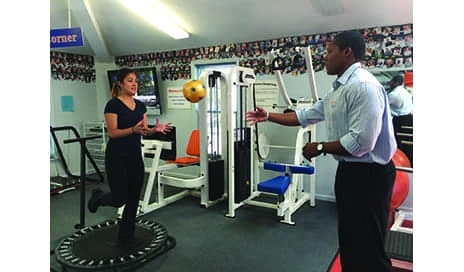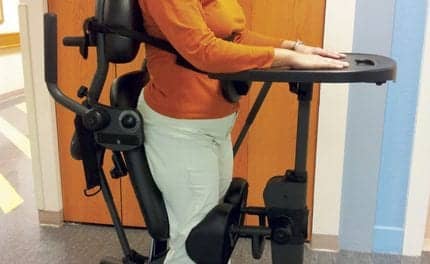
Evidence-based research articles have confirmed the effect of preoperative therapy, also referred to as “prehab,” on postoperative return to function. Ivonne, a patient who is participating in a prehab program, works with Stephen G. Linton, PT, DPT, on neuromuscular re-education and proprioception, performing ball tosses on a trampoline.
By Stephen G. Linton, PT, DPT
Murphy’s Law states, “Anything that can go wrong, will go wrong.” That may not be the case, however, for the therapist who is prepared.
Preparation means taking strategic actions to get ready for an event or change that will take place. This article will detail the benefits therapists can reap for themselves and those they treat by exploring The Preoperative Rehabilitation Exercise Program (PREP) at The Physical Therapy and Wellness Institute (PTW), headquartered in Lansdale, Pa. In particular, this exploration will detail the role of personal strategic planning in optimizing a patient’s level of strength and function prior to undergoing surgery. From a patient’s point of view, hearing a physician recommend surgery can be unsettling, leaving the patient unsure about what he or she can do, themselves, to make the process easier. This is where a therapist and an outpatient clinic can engage the patient in a program to help smooth the road to surgery as well as the postsurgical outcome.
Providing guidance to presurgical patients is one of the most important contributions a therapist can make during the episode of care. This includes a thorough and honest education of rehab potential and development of a strengthening program. Likewise, a progression of range of motion deficits and a reduction of pain are vital in helping patients toward a fast and efficient postoperative recovery. In short, the goal of the therapist is to construct an individualized, evidence-based program centered on the specific needs of the patient.
To ensure those needs are met, the therapist must construct this program with the patient’s ultimate goal in mind, whether that goal is to dance at a daughter’s wedding, return to activities or work duties, or win an Ironman competition. Paramount to helping patients toward those goals is helping them optimize the levels of their potentiality prior to undergoing surgery. The PREP program is structured to help the patient population about to undergo surgeries that include rotator cuff repair, ACL repair, total shoulder replacement, hip or knee replacement, meniscal repair/removal, and spinal fusion/discectomy.
What is PREP?
The opening phase of PREP is marked by an evaluation to determine the patient’s specific needs by objective functional measures and assessments, which subsequently are compiled and delivered to the surgeon. The physical therapy clinic provides the patient and his or her physician with data from relevant tests that include ambulation endurance tests, balance measures, strength tests, pain measures, range of motion assessments, and perceived functional deficits that will be taken at the initial and end of the PREP program. A supervised program is established to meet the patient’s goals and enhance overall performance and recovery.
Evidence-based research articles have confirmed the effect of preoperative therapy, also referred to as “prehab,” on postoperative return to function. It has been reported that, on average, thousands of dollars in overall care can be saved by using a prehab program. Among this savings is a decrease in time spent in hospital after surgery. Likewise, it has been reported that a 29% reduction in the number of postoperative therapy visits can be achieved with up to half of patients eliminating the need for postoperative care therapy overall. Some of the most significant benefits attributed to preoperative care include maintenance/improvements in range of motion, strength increases, and improving neuromuscular control. Research shows that those who are lacking in these areas are indicative of patients who require prolonged care postoperatively. Multiple considerations must be made, then, in striving for an optimum outcome. This means therapists must concentrate not only on the physical aspects of preparation but also emphasize the importance of mental confidence and full understanding of postoperative needs, expectations, and outcomes. As a result of this approach, patients have demonstrated decreased pain levels and improved gait patterns postsurgery, allowing for an easier return to activities of daily living. Prehab facilitates a reduction in the risk of complications postoperatively and minimizes the need for a second surgery due to reinjury, based upon rehab potential.
Maximizing Potential
Rehab potential is not based on a scientific equation or an algorithm with categories into which individuals are placed. Rehab potential is an educated analysis performed by an experienced therapist that considers a patient’s co-morbidities, prior surgeries, prior therapies, chronicity or acuity of deficits, functional decline, medication tolerance/usage, patient goals, motivation level, and support system. It is crucial for the therapist to ensure that goals are measurable, obtainable, and realistic, agreed-upon, and motivating. Other factors may be taken into account, such as insurance coverage, financial ability, vacations, work return demands, time in the restrictive device postop, and frequency of therapy visits. By preparing patients mentally and physically for the challenges they may face, the therapist begins to prepare their minds, priming them to develop the confidence to realize their potential and achieve success.
A Next Level Attitude
Cultivating a next level attitude is paramount to this success. A positive mind goes a very long way when recovering from any injury. The therapist must provide an atmosphere that engenders a positive mind-set while improving the body. It begins with the attitude of the staff and therapist who performs the evaluation from the minute the patient enters the clinic. To establish these conditions, it may be helpful to ask the following question: Is the clinic inviting? Are the lights bright? Are staff members warm and compassionate, yet energetic? Do therapists introduce themselves to their patients prior to beginning paperwork? Are therapists reminding patients about their goals at each encounter and reinforcing the idea that completing this program will help them achieve their goals? There is no waiting room at PTW, which is a characteristic of the clinic’s design that leads patients to feel they are being cared for as soon as they walk in the door. The clinic also employs a well-known “Road to Recovery” that is used as a celebration and motivator to patients and therapists.
Developing an Atmosphere for Progress
The Road to Recovery is a painted road on the clinic’s interior wall that is adorned with photographs of all graduated patients on their last day of therapy. This is a staple and testament to the patient’s journey toward achieving his or her rehabilitation goals. Many PREP program participants appear among these photographs. These images can be used with patients to reinforce the belief that with the conviction to push through the challenges of therapy, they will be successful. To motivate patients and help them visualize their recovery, therapists can point to patients depicted in the photographs who shared similar conditions. This offers a touchstone for conversations between therapists and patients as well as a way to make the prospect of recovery “real.”
Another tactic that can be utilized is placing patients of similar deficits near one another in the clinic. This is most effective in clinics where an inviting atmosphere has been developed and where patients may root each other on and share stories of similar paths. This arrangement helps a patient to get a firsthand, unbiased opinion about the process from their peers, and hear other patients relate the importance of having attended the PREP program prior to surgery. Patients may also discuss the timeline for recovery after surgery as well as how they moved through certain setbacks. The sense of community a patient can develop from this type of interaction can be quite beneficial and motivating.

Aquatic therapy is a highly effective recovery tool that is often underutilized. Here, PTW patient Barb is guided through aquatic therapy to help improve her ambulation endurance and strength in her core and lower extremities.
Communication
Therapists will need to reach out to surgeons to discuss the type of surgery the patient will have and the direction of the prehab. Anything the surgeon would like to avoid should be addressed in the discussion. Once surgeons have been made aware of the availability of this option in the clinic versus strictly postoperative care, they may be more likely to refer patients to that clinic rather than another. Surgeons are pleased to see their patients achieve superior results, which improve the surgeon’s ratios and outcomes for a particular procedure. Furthermore, surgeons are adamant about the need for quick recovery, allowing for better long-term effects of the surgery and return to normal function. PTW works very closely with surgeons, home care therapists, acute therapist, and family members to facilitate a holistic team approach for the patient plan of care.
Homework
Not only are patients given a set of interventions to be performed in the clinic, they also are given a home exercise program for the purpose of maintaining results between sessions. Patients are sent home with recommendations for adaptive modifications needed in the home for postop transition, family training for caregivers, and help with acquiring assistive devices that may be required. It is vital to have open communication and participation with family members or friends about the types of assistance a patient will need postoperatively. Having a support system involved prior to surgery can contribute significantly to the ability of patients to reach their goals because of the accountability and inspiration members of that support system can offer.
As the patient progresses through the program each week, their progress is discussed. Changes can be made based on tolerance to strengthening interventions, ROM improvements, gait symmetry improvements, functional ability with ADLs, and pain levels. When progressing patients it is important to have Conservative Aggression, which is the level at which the therapist can push the patient for optimal results while still maintaining a safe environment for the affected area or damaged body part.

Using technology designed to reduce body weight, prehab patient Rita works with her therapist to improve her gait pattern after having bilateral knee replacements.
Tools
A) Aquatic therapy is a highly effective tool for recovery that is often underutilized. It provides full non-weight-bearing strengthening interventions, vasodilation to improve blood flow promoting relaxation to skeletal musculature, endurance training, and range of motion improvements.
B) Machines that provide multi-planar cardio exercise can provide excellent lower extremity strength activity needs where strong gluteal muscles help to keep the pelvis level and initiate push-off, exploding through to the next step, similar to a skiing motion.
C) A gravity-eliminated treadmill can reduce the body’s weight to a mere 20% while also utilizing visual feedback through the use of real-time cameras. This helps with those who have weight-bearing issues and require endurance training in pain relieving ways of regaining their mobility, ranging from normal ambulation to sprinting the 100 meter dash.
D) An adaptive motion trainer can utilize various free motion patterns to engage the core, lower extremities, and upper extremities, allowing for replication of any motion needed during activity, whether climbing stairs, hiking, or running.
E) More commonly utilized are elastic resistance bands with loops, wobble boards, balance boards, trampolines, shuttle balance machines, shuttle press machines, slide boards, pulleys, and other resistive equipment. Modalities including electrical stimulation, ultrasound, cold/hot whirlpool, cold sleeve compression systems, and iontophoresis can be utilized to help eliminate pain levels, decrease swelling, and improve muscle tone.
Pain Education
Pain— whether referred, radicular, phantom, acute/chronic, and/or neurogenic—is the primary symptom that leads patients down the road to surgery. During therapy, the reduction of pain is achieved with the utilization of modalities such as ultrasound and electrical stimulation TENS, activity modification, education, manual techniques, mirror therapy, and mental imagery.
Education is key in the beginning of this process, allowing patients to understand the prognosis of pain in relation to their functional improvements leading up to surgery and postsurgery. By sitting down with the patients, therapists can make them more aware of what to expect and ease their anxiety. It allows them to have an increased pain threshold and improved tolerance to interventions utilized in their program. Research has shown that a higher percentage of reduced pain levels are seen postsurgery when patients have taken part in a prehab program.
Compensation
A cash-based system has been developed to charge for this program at PTW, which makes services available at an affordable rate outside of insurance benefits. Patients who have financial hardships can sit down with their therapist to develop a payment. There is also an option to perform the intervention in a guided program through physical therapy based on a patient’s insurance. PTW has two programs, either 4 or 6 weeks, which can be determined between the therapist and patient based on surgical need and prior level of function.
Within this program, start and end measurements will be taken in addition to information at the discharge of postoperative care. Patients who perform the PREP program will be seen after surgery for therapy. This is not a requirement of the program, but a natural trend observed due to having already built trust between patient and therapist. The clinic can then reach out to patients at 6 months and 1 year postsurgery to track their pain levels, function, and percent of perceived normal function. This aspect of the program has been beneficial for marketing the clinic to primary care physicians or surgeons, as well as for raising awareness among patients and those with whom they socialize.
Completion of Program
After being discharged, the PREP patients have reported that they felt mentally and physically prepared for surgery, with their postop recovery being directly paralleled or better than what was expected. Patients have largely decreased pain levels, quicker recovery of strength, improved balance, decreased edema, and enhanced confidence with activities of daily living. Preparation is key for a smooth journey that follows the road map to recovery. RM
Stephen G. Linton, PT, DPT, is clinical supervisor for The Physical Therapy & Wellness Institute’s Harleysville, Pa, location. He earned a bachelor’s degree in biology and a doctorate of physical therapy from the University of the Sciences, Philadelphia. Linton also earned his McKenzie Part A certification. He is a member of the APTA and has a strong interest in vestibular/dizziness rehabilitation and McKenzie techniques. For more information, contact [email protected].





